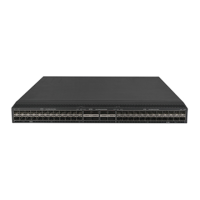5
Enabling MVRP
1. Enter system view.
system-view
2. Enable MVRP globally.
mvrp global enable
By default, MVRP is globally disabled.
For MVRP to take effect on a port, enable MVRP both on the port and globally.
3. Enter Layer 2 Ethernet interface view or Layer 2 aggregate interface view.
interface interface-type interface-number
4. Configure the port as a trunk port.
port link-type trunk
By default, each port is an access port. For more information about the port link-type
trunk
command, see Layer 2
—
LAN Switching Command Reference.
5. Configure the trunk port to permit the specified VLANs.
port trunk permit vlan { vlan-id-list | all }
By default, a trunk port permits only VLAN 1.
Make sure the trunk port permits all registered VLANs.
For more information about the
port trunk permit vlan command, see Layer 2
—
LAN
Switching Command Reference.
6. Enable MVRP on the port.
mvrp enable
By default, MVRP is disabled on a port.
Setting an MVRP registration mode
1. Enter system view.
system-view
2. Enter Layer 2 Ethernet interface view or Layer 2 aggregate interface view.
interface interface-type interface-number
3. Set an MVRP registration mode for the port.
mvrp registration { fixed | forbidden | normal }
The default setting is normal registration mode.
Setting MRP timers
Restrictions and guidelines
When you set MVRP timers, follow these restrictions and guidelines:
• Follow the value range requirements for Join, Leave, and LeaveAll timers and their
dependencies as described in Table 1. If you set a timer to a valu
e beyond the allowed value
range, your configuration fails. You can set a timer by tuning the value of any other timer. The
value of each timer must be an integer multiple of 20 centiseconds.

